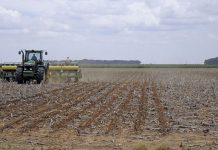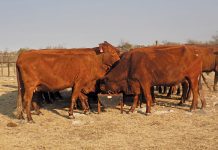It looks as if the long-awaited sugar beet ethanol project near Cradock in the Eastern Cape is about to bear fruit. The project needs at least 4 000ha of sugar beet, which will create 1 500 jobs, but farmers are reluctant to commit to 10-year contracts for a time-intensive crop that may not be profitable. Julienne du Toit reports.
If all goes as planned, construction on a large ethanol-from-sugar beet plant could start outside Cradock some time this year. However, farmers haven’t yet committed a single hectare to growing sugar beet, saying they’ll only do so if it’s more profitable than their existing crops. At least 4 000ha must be committed to planting before the R1,5 billion plant can be built. Negotiations are still ongoing.
Ethanol from sugar beet A sugar refinery was envisaged in the Fish River Valley 12 years ago, but in 2007 it was announced sugar beet would be used to make ethanol for biofuel. A joint venture was formed between the Industrial Development Corporation (IDC), the Central Energy Fund and Sugar Beet RSA Ltd. A site for the plant was recently bought right across the Great Fish River from Lingelihle township, about 4km from the centre of Cradock. This has caused consternation among tourism operators, who want to market the town as a health destination.
Noel Kamrajh of the IDC confirms the R1,5 billion needed to create the state-of-the art ethanol plant is being arranged. If the environmental impact assessment, now reaching its final stages, is approved by the Eastern Cape government, local farmers need to commit to growing at least 4 000ha of sugar beet in the first year – preferably 6 000ha or more before the construction of the plant can go ahead. Without guaranteed feedstock, building the plant would be a pointless and expensive exercise, says Noel.
Since sugar beet, an annual crop, can only be grown in the same soil again after three years, between 12 000ha and 18 000ha have to be secured in total. Noel brushes aside questions about a cut-off date for farmers to pledge their land, saying joint-venture stakeholders are confident of commitment. “We probably know far more about farming sugar beet than the farmers do at this stage,” he explains. “After all, we’re going to control a large portion of the operation. All the farmer needs to do is plant, put in the herbicide, fertiliser and water, and make sure the crop grows.”
Contracts and wrangling
Hilton Collett, a Fish River Valley farmer on the board of Sugar Beet RSA, confirmed negotiations are in progress between farmers of the Energy Producers Organisation and the joint venture. “This valley doesn’t have much experience with contracts,” he pointed out. “But look at the farmers growing vegetables in the Gamtoos Valley. They won’t plant unless they’ve got a contract. So maybe you won’t get the very top price, but you won’t get the lowest either. And a contract stabilises your whole farming venture because you can plan. You’ll know you can at least cover your rates and taxes and wages.”
At this stage it seems certain any farmers willing to grow sugar beet will have to commit themselves for a number of years. “We’re discussing the length of the contract, and the formula by which farmers will be paid,” says Hilton. “The formula will enable farmers to compare their present enterprises and must show incorporating sugar beet to be more profitable. Producers’ crops will be sampled for sucrose level and soil percentage. Farmers will be paid per ton of clean beet and for the sucrose extracted.”
According to the contract, the farmer covers the costs of maintaining roads and bridges for the 30t trucks and trailers, buying or adapting planters, buying seed, fertiliser and herbicide, and irrigation.
The plant covers harvesting and transport.
Sticking points
The contracts have created sticking points in the past. Michael Vermaak, a major crop farmer outside Cookhouse, hosted commercial sugar beet trials on his farm Van der Lindenskraal. “Our big fight has been over price,” he says. “And I’m not prepared to sign a contract for 10 years. A lot can change in 10 years.” However, Hilton says the contracts are being reviewed, and will likely commit farmers to a shorter period. Another sticking point is the time sugar beet stays in the ground – 13 months during farmer Danie Erasmus’s trials on Grootplaas near Somerset East. “Compare that to maize silage, which is harvested and earning us money in about four months,” says Danie. “Sugar beet isn’t a bad crop to grow, but I’m not convinced it will be financially viable. It would have to be an excellent deal before I put up my hand.” The crop’s three-year rotation period doesn’t put Michael off. “I think farmers with flood irrigation will struggle a lot more with weeds than those with overhead irrigation,” he concludes. “In our trials, we applied herbicide twice. We also found sugar beet uses roughly the same amount of fertiliser and water as maize.”
End products
The beets, which weigh between 1,5kg and 3kg, will contain about 4% soil.
This will be washed off at the plant and set aside, where it’s likely to be available for anyone willing to come and pick it up, says Hilton. The plant will produce 90 million litres of ethanol a year, which may be sent to the refinery at Mossel Bay (or the planned one at Coega), as well as 75 000t of animal feed. It still hasn’t been decided whether a certain amount of the feed will be made available for local farmers to buy, or whether it will simply be on sale to the highest bidder.
Another loose end is the precise mechanics of selling the ethanol produced to the petroleum industry for inclusion in South Africa’s fuel supply. Noel confirms that initially this ethanol would make up 2% of the fuel supply, which could increase to 10% by the year 2016. Anton Moldan of the South African Petroleum Industry Association (SAPIA) points out there are a number of issues government needs to address before ethanol can be adopted successfully, especially the economics.
“Large amounts of capital will be needed to adapt refinery processes and to change the distribution infrastructure before ethanol at levels greater than 2% can be blended with petrol,” he warns.
In all other countries that have introduced biofuel, government assistance was needed to spread the burden of the costs, he says. “This approach needs to be investigated in our local market.”
E-mail Hilton Collett at
[email protected]. |fw








